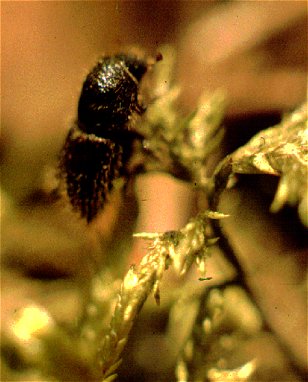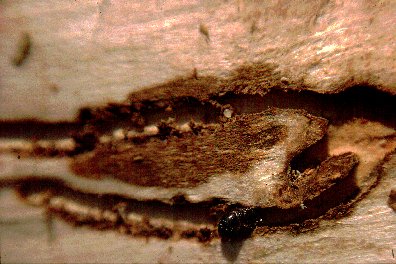 Ips typographus L.
Ips typographus L.
The larger European spruce bark beetle (or eight-spined spruce bark beetle) is shown preparing to take flight after emerging from the
forest duff on a warm spring day. I. typographus is found in Europe and northern Asia where it is a pest on Norway spruce, Picea abies. Males have 4 spines on the backend of each elytron (or 8 spines in total as these beetles have two elytra as do all
beetles). Females look almost identical to males and for many years it was thought impossible to differentiate the sexes under the microscope without resorting to
dissection of the genitals. It is possible to separate the sexes after some experience since males have a larger knob in the middle of the "face"
than do females, and males have fewer (less dense) hairs on the pronotum than females. The pronotum is the area of the thorax just behind the head on the top of the body.
This beetle, as many other so-called aggressive bark beetles, also introduces fungi that help paralize the tree's ability to produce resin
that is used by the tree to repel the beetles when they are trying to bore into the tree (called attacks). The beetles must attack a standing tree in large numbers to insure that enough
fungi are introduced to kill the tree before it can produce resin and repel/kill the beetles. This species and many other bark beetles use aggregation pheromone
to attract more individuals of the same species to the tree for the purpose of killing the tree and for mating. In I. typographus, two chemicals
(methyl butenol and cis-verbenol) comprise the aggregation pheromone that is produced
by the male (females produce some cis-verbenol). The pheromone attracts both sexes. The attracted males want to join the attack and secure an area for his and
several female's young, while the females want to find a male-dug hole and room (called "nuptial chamber") beneath the bark where she can begin a tunnel in which to lay eggs along the sides.
 The tunnels are excavated only in the thin phloem layer just under the thin bark of Norway spruce. The phloem layer is only about 2-4 mm thick in Norway spruce and is rich in sugars and nutrients since this is
the layer that transports photosynthate (sugars/amino acids made by photosynthesis) from the needles to the roots. In all species of Ips
there are several females (from 1 to 4) that join the single male in his nuptial chamber.
The male seems to regulate the number of females joining him in his nuptial chamber since more than 4 will cause too much competition among the larvae.
The male blocks the entrance tunnel with his spiny elytra and keeps other males from stealing his burrow and also attempts to
keep out predators and parasites eager to lay eggs in his young. The females dig the egg tunnels (one tunnel per female) away from the central chamber for 10 or more centimeters, laying
eggs on each side of the gallery. Her eggs are enormous compared to her body, when compared to human size her eggs are about the size of a watermellon! Yet in her short egg-laying life (about 3 weeks) she may lay
more than 50 eggs.
Since there is a 1 to 1 (male:female) sex ratio of larvae and emerging adults,
this means that many males never have young during their lifetime. This is also true of other polygynous
bark beetles such as those in the genus Pityogenes, while many bark beetles in the family Scolytidae (but in the other subfamily) have a monogamous mating system in which
the female usually attacks the tree first and is joined later by a male (for example the genera Dendroctonus. and Tomicus.
The tunnels are excavated only in the thin phloem layer just under the thin bark of Norway spruce. The phloem layer is only about 2-4 mm thick in Norway spruce and is rich in sugars and nutrients since this is
the layer that transports photosynthate (sugars/amino acids made by photosynthesis) from the needles to the roots. In all species of Ips
there are several females (from 1 to 4) that join the single male in his nuptial chamber.
The male seems to regulate the number of females joining him in his nuptial chamber since more than 4 will cause too much competition among the larvae.
The male blocks the entrance tunnel with his spiny elytra and keeps other males from stealing his burrow and also attempts to
keep out predators and parasites eager to lay eggs in his young. The females dig the egg tunnels (one tunnel per female) away from the central chamber for 10 or more centimeters, laying
eggs on each side of the gallery. Her eggs are enormous compared to her body, when compared to human size her eggs are about the size of a watermellon! Yet in her short egg-laying life (about 3 weeks) she may lay
more than 50 eggs.
Since there is a 1 to 1 (male:female) sex ratio of larvae and emerging adults,
this means that many males never have young during their lifetime. This is also true of other polygynous
bark beetles such as those in the genus Pityogenes, while many bark beetles in the family Scolytidae (but in the other subfamily) have a monogamous mating system in which
the female usually attacks the tree first and is joined later by a male (for example the genera Dendroctonus. and Tomicus.
Selected scientific references and abstracts on Ips typographus:
Flight, dispersal, control, trapping, overwintering, energy:  45K file
45K file
Behavior, biology, chemical ecology, parasites:  48K file
48K file
Image © 1996 by John A. Byers, Chemical Ecology.
 Ips typographus L.
Ips typographus L. The tunnels are excavated only in the thin phloem layer just under the thin bark of Norway spruce. The phloem layer is only about 2-4 mm thick in Norway spruce and is rich in sugars and nutrients since this is
the layer that transports photosynthate (sugars/amino acids made by photosynthesis) from the needles to the roots. In all species of Ips
there are several females (from 1 to 4) that join the single male in his nuptial chamber.
The male seems to regulate the number of females joining him in his nuptial chamber since more than 4 will cause too much competition among the larvae.
The male blocks the entrance tunnel with his spiny elytra and keeps other males from stealing his burrow and also attempts to
keep out predators and parasites eager to lay eggs in his young. The females dig the egg tunnels (one tunnel per female) away from the central chamber for 10 or more centimeters, laying
eggs on each side of the gallery. Her eggs are enormous compared to her body, when compared to human size her eggs are about the size of a watermellon! Yet in her short egg-laying life (about 3 weeks) she may lay
more than 50 eggs.
Since there is a 1 to 1 (male:female) sex ratio of larvae and emerging adults,
this means that many males never have young during their lifetime. This is also true of other polygynous
bark beetles such as those in the genus Pityogenes, while many bark beetles in the family Scolytidae (but in the other subfamily) have a monogamous mating system in which
the female usually attacks the tree first and is joined later by a male (for example the genera Dendroctonus. and Tomicus.
The tunnels are excavated only in the thin phloem layer just under the thin bark of Norway spruce. The phloem layer is only about 2-4 mm thick in Norway spruce and is rich in sugars and nutrients since this is
the layer that transports photosynthate (sugars/amino acids made by photosynthesis) from the needles to the roots. In all species of Ips
there are several females (from 1 to 4) that join the single male in his nuptial chamber.
The male seems to regulate the number of females joining him in his nuptial chamber since more than 4 will cause too much competition among the larvae.
The male blocks the entrance tunnel with his spiny elytra and keeps other males from stealing his burrow and also attempts to
keep out predators and parasites eager to lay eggs in his young. The females dig the egg tunnels (one tunnel per female) away from the central chamber for 10 or more centimeters, laying
eggs on each side of the gallery. Her eggs are enormous compared to her body, when compared to human size her eggs are about the size of a watermellon! Yet in her short egg-laying life (about 3 weeks) she may lay
more than 50 eggs.
Since there is a 1 to 1 (male:female) sex ratio of larvae and emerging adults,
this means that many males never have young during their lifetime. This is also true of other polygynous
bark beetles such as those in the genus Pityogenes, while many bark beetles in the family Scolytidae (but in the other subfamily) have a monogamous mating system in which
the female usually attacks the tree first and is joined later by a male (for example the genera Dendroctonus. and Tomicus.
 45K file
45K file 48K file
48K file